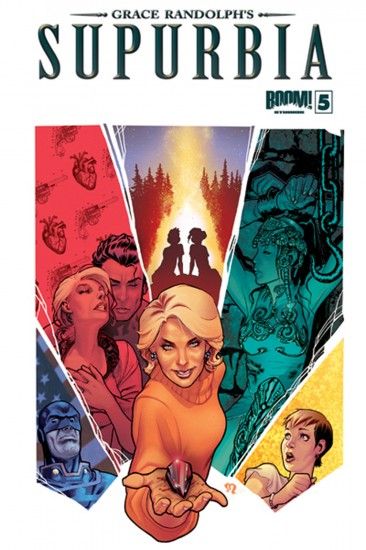Grace Randolph and Russell Dauterman's "Supurbia" #5 plays catch-up with lives and loves of superheroes that live in the same 'burb. Randolph has captured in her scripts the pacing and feeling of a TV drama like "Desperate Housewives" or even more to the point, a soap opera, and in doing so, her story inherits the inherent strengths and weakness of those forms.
Randolph's focus is still far more on the characters' relationships than on their powers. Some villainous deeds are on-screen, but no crime-fighting is shown. "Supurbia" really isn't a superhero comic; it's more of a drama comic that plays with the superhero archetype toy chest.
The action in "Supurbia" is only to provide more fodder for the web of romantic and familial relationships, and like dramas or soap operas, most of the action occurs within the same small interconnected local community. The narrative revolves tightly around intensely melodramatic tropes like secret romances, attempted filicide, crime and redemption, rescues and conversions.
Randolph's excellent cast has characters with wildly differing ages, ethnicities, ambitions and secrets. Despite being riffs on Batman and Robin, Superman and Wonder Woman, her characters aren't only subversions or tokens, although they obviously serve in those roles too. Paul, the Batman of "Supurbia," is sympathetic despite his internalized homophobia and treatment of his Robin-esque lover. Reformed-but-still-homicidal villainess Hella Heart seems oddly fragile in her desire to be loved and aspiring young villainess Sara Metzger is similarly attractive in her addictive enthusiasm. All three strive for a new identity and this universal touchstone further makes them sympathetic in their flaws.
Russell Dauterman's artwork in "Supurbia" #5 continues to be excellent. Despite the many jumps in setting and the large size of the cast, he keeps the action exciting yet fluid and easy to follow, and his character designs have distinctive body types and facial features. His background detail, camera angles, page compositions and Cassata's attractive coloring continue to make "Supurbia" visually exciting and well-crafted.
The flaws of "Supurbia" #5 also come from the soap opera form. In particular, the pacing has a molasses-slow feeling, as Randolph moves each member of her very large cast forward just a few steps, and then suddenly the issue is over. Also, the amount of drama created by all these secrets and hatreds and desires is disproportionally larger than the number of insights about human nature gleaned. In other words, like other soaps, "Supurbia" #5 shows signs of milking turbulent events and emotional turmoil for maximum effect without necessarily offering any substantive commentary.
The real meat of "Supurbia" has been how Randolph plays with character types within the melodrama framework. I've heard comparisons to Garth Ennis' "The Boys," and that's not as crazy as it sounds, because the two titles share a common purpose. There's less subversion and sharp insights in "Supurbia" #5 than in previous issues, because there's hardly any room as the cast shifts around on the big chessboard of their shared lives.
The ending cliffhanger promises a new wave in the plot, and overall, "Supurbia" is still a good read, enjoyable like a good TV show while still occasionally showing that deeper layer of social or psychological insight underneath the gloss.

